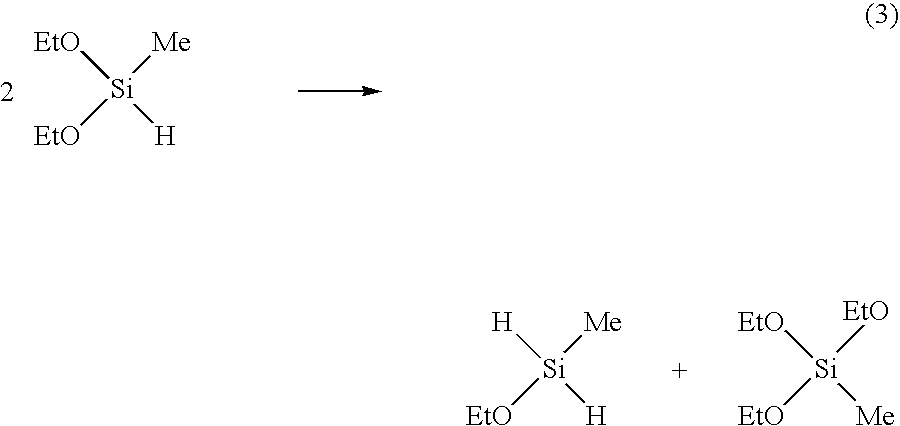Stabilization of nitrogen-containing and oxygen-containing organosilanes using weakly basic ion-exchange resins
a technology of ion exchange resins and organosilanes, which is applied in the direction of silicon organic compounds, organic chemistry, chemistry apparatus and processes, etc., can solve the problem of organicsilane product decomposition by itsel
- Summary
- Abstract
- Description
- Claims
- Application Information
AI Technical Summary
Benefits of technology
Problems solved by technology
Method used
Image
Examples
example 4
Use of Ion Exchange Column to Treat BTBAS
[0058]The procedure of Example 2 was repeated except that the BTBAS was contacted with Amberlyst A-21 ion exchange resin manufactured by Rohm and Haas. The resin is a weakly basic macro-reticular resin with tertiary amine functionality. The Amberlyst A-21 resin was initially washed with greater than 10 volume equivalents of double de-ionized (DI) water (@18.2 Ω / cm) and then dried under vacuum and temperature for three days. If contaminating anions are present, it is believed the resins will remove anions pursuant to following equation:
M+A−(solid resin)+B−(solution)·M+B−(solid resin)+A−(solution)
[0059]where A and B are the counter ions and M+ is the insoluble fixed cationic complement.
[0060]The first ion exchange column treatments were started. BTBAS samples were gravity fed through the ion exchange column bed at the rate of 4 bed volumes per hour. Material was passed through only once. The pH will remain within the range of 7 to 8 unless BTBA...
example 5
Effect of Weakly Basic Macroreticular Resin Extended Treatment on BTBAS Stability
[0062]The procedure of Example 3 was repeated except that the BTBAS was contacted with Amberlyst A-21 ion exchange resin over an extended period of time. In carrying out the test, one sample set of extremely stable BTBAS and one sample set of extremely unstable BTBAS samples were soaked with dried A21 resin for 24 hours and then the BTBAS decanted off the resin. In another set, the samples remained in continuous contact with the resin for 41 days which constituted this test.
[0063]Results were compared against untreated samples for both the stable and unstable materials. The unstable BTBAS blank or untreated sample formed S-2 at a rate of 20.1 ppm per day. The BTBAS sample bulk soak with Amberlyst A-21 resin for 41 days generated 9.9 ppm per day of S-2 and thus decreased the decomposition of BTBAS by 50%. The BTBAS sample exposed to Amberlyst A-21 for a 24 hour exposure generated the most stable BTBAS pr...
example 6
Effect of Weakly Basic Macroreticular Resin Extended Treatment on BTBAS Stability Over 58 Days
[0065]The procedure of Example 5 was followed except that stability was measured over a 58 day testing period and treatment was effected over different time periods. Two batches of BTBAS were studied, one with normal stability (1.3 ppm S-2 formation per day) and the other being moderately unstable (11 ppm S-2 per day).
[0066]In one set of runs the contact time of the BTBAS samples with Amberlyst A-21 resin was 3 hours of soaking and in another set runs the samples remained in constant contact with the A21 resin over the 58 days of the experimental run. These runs were compared with control samples where the stable and unstable BTBAS samples remained untreated.
[0067]The three hour contact of unstable BTBAS reduced the S-2 formation from 11 to 2.2 ppm per day. The bulk soak of BTBAS of the unstable BTBAS dropped S-2 formation from 11 down to 9.4 ppm per day.
[0068]The normal stability BTBAS mat...
PUM
| Property | Measurement | Unit |
|---|---|---|
| residence time | aaaaa | aaaaa |
| contact time | aaaaa | aaaaa |
| ion exchange | aaaaa | aaaaa |
Abstract
Description
Claims
Application Information
 Login to View More
Login to View More - R&D
- Intellectual Property
- Life Sciences
- Materials
- Tech Scout
- Unparalleled Data Quality
- Higher Quality Content
- 60% Fewer Hallucinations
Browse by: Latest US Patents, China's latest patents, Technical Efficacy Thesaurus, Application Domain, Technology Topic, Popular Technical Reports.
© 2025 PatSnap. All rights reserved.Legal|Privacy policy|Modern Slavery Act Transparency Statement|Sitemap|About US| Contact US: help@patsnap.com


